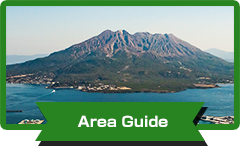
-

-
Geopark is a “park of the Earth”. The earth is like a big park where you can enjoy the stories of relationship between the Earth and human beings from the past to the future! Including mountains, oceans and forests, there are many natural attractions that have been created over millions of years.
There are many ways to enjoy Sakurajima-Kinkowan Geopark. You can enjoy the incredible scenery, tours, events, activities and local products. Let’s discover the wonders of Sakurajima and Kinko-Bay!
Don’t miss it! Sakurajima-Kinkowan Geopark
– The relationship between the volcano and people –
1.The volcano and people are coexisting!
How amazing that 600,000 people live alongside the active Sakurajima volcano that actively erupts on a daily basis. Disaster prevention measures are taken using the world's best high-tech volcanic monitoring system. This allows people to live near the active volcano in safety. Kagoshima is a unique place where an active volcano and an urban city coexist.
2.The sea made by the volcano!
Kinko-Bay spreading in front of Sakurajima was actually made by the volcano. About 30,000 years ago, a large amount of magma was released after a huge eruption occurred in the inner side of Kinko-Bay. This caused the land to become empty and dented. The dented area is called Aira Caldera. The 200m-deep Kinko-Bay was formed after the seawater entered in it.
3.The eruption of Sakurajima
The history of Sakurajima is called the history of eruptions. There have been 17 huge eruptions up until today. The history of Sakurajima’s volcanic activity can be divided into 2 periods. From the time Sakurajima was born until 5,000 years ago, the North Peak was active. Since 4,500 years ago, the South Peak has been active ever since. As the two volcanoes; the North Peak and the South Peak line in a row, Sakurajima looks wide.
The biggest eruption in the history of Sakurajima occurred about 13,000 years ago. The eruption covered Kagoshima city with ash as deep as 1m and the whole of Kagoshima prefecture was covered with at least 10cm of ash. Another huge eruption that changed the shape of Sakurajima occurred in 1914. The lava flow connected the former Sakurajima island to Osumi peninsula during the eruption. Kurokami Buried Shrine Gate and Karasujima Observatory tell us how huge the eruption was.
4.Life on Kagoshima
The residents of Kagoshima do not care about the small eruptions. They are used to eruptions because Sakurajima erupts over hundreds of times each year. Since the people of Kagoshima have coexisted with the volcano for many years, disaster prevention measures are well organized.
You may find the residents' knowledge to coexist with the volcano by observing their daily lives. For example, there are yellow Kokuhai Bukuro bags for collecting volcanic ash in Kagoshima. Also, students in Sakurajima wear helmets to protect their heads from volcanic debris.
5.You can experience Sakurajima and Kinko-Bay!
Sakurajima-Kinkowan Geopark has many Geo-Sites where you can play and learn about the land and its long volcanic history. Find out how the people have lived with the volcano by learning about the products and historical sites of the land related to the volcano. You can also enjoy exciting activities, tours, unique products and local meals. Where would you like to begin?
Relationship between the volcano and people – 6 stories

Relation with the landscape and geology
-
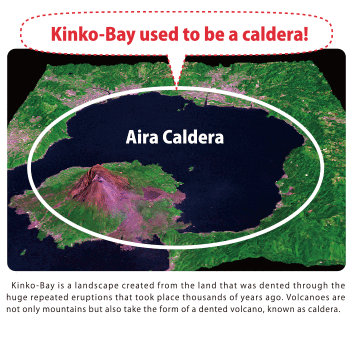
-
About 29,000 years ago in Kagoshima, there was a huge eruption that was a million times bigger than the eruptions we currently see at Sakurajima.
Kagoshima was covered with magma flow that was as thick as 60m.
The large amount of magma that jetted out caused the land to sink created Aira Caldera. Kagoshima was covered with a mixture of volcanic stone, ash and gas that were combined under a heat of 600 degrees, a phenomenon called pyroclastic flow. This covered the mountains and valleys of Kagoshima, making it into flat land within a week. Shirasu tableland was later created through the rivers that carved out the land.Sakurajima’ s first volcanic activity started 26,000 years ago in the southern part of the caldera. Repeated eruptions formed the North Peak; the first volcanic body and South Peak; the second volcanic body of Sakurajima, shifting the position of the crater. Shirasu tableland where you stand today, Sakurajima and Kinko-Bay were all connected to the huge eruption that took place many years ago.

-

-
The spot to experience the power of the volcano!
Looking down Aira Caldera from Terayama-park observatory spot, you will notice a huge dented area at the far end of Kinko-Bay. This is the caldera. Experience the great power of the volcano while having a great view of Sakurajima!
-

-
Check the surface of the mountain!
The surface of Kita-Dake is rough compared to that of Minami-Dake. The Showa Crater located in the eastern steep of Minami-Dake is covered by volcanic products from new eruptions, so its surface is very smooth.
-

-
It is of ten mistaken that Shirasu tableland is made up of ash from Sakurajima millions of years ago. However, Shirasu tableland was actually created by AiraCaldera’s huge eruption only in a week.
-

-
Although Sakuraijma looks like one mountain, it is actually consisted of two volcanoes, Kita-Dake and Minami-Dake! Kita-Dake was active from the birth of Sakurajima which is 26,000 years ago until about 5,000 years ago. Later on, the crater moved to the South, and its volcanic activity started about 4,500 years ago and still continues today.
These two mountains that range from north to south make up Sakurajima. This is why Sakurajima looks wide from Kagoshima city.

Relationship with nature
-
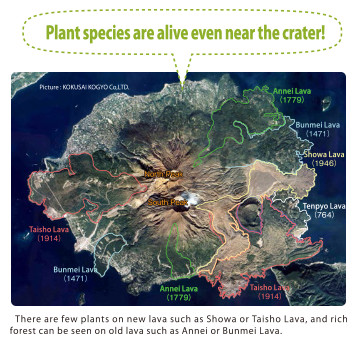
-
Plant species cannot live under severe volcanic environment? No,there are Japanese pampas grass and Japanese knotweed near the crater and they are strong against volcanic gases. A little further from the crater, there are Eurya Japonica and Alnus firma. In the area the furthest form the crater, Machilus thunbergii and Japanese black pine can be seen.
The plants on the ground are covered with lava and the ground is filled with rocks by each eruption, but plants grow back every time. At first, Mosses and Lichenes start to grow, and then a meadow will be formed. Intolerant trees such as the Japanese black pine follow. Then, shade trees such as Muchilus thunbergii will come out. In this way, the volcanic ground becomes a forest over many years. Sakurajima is a natural museum because you can observe the changes of vegetation on the variety of lava made in different eras.

-

-
Identify plant species of three generations!
Arimura beach has lava of 3 different eras; Annei(1779), Taisho(1914) and Showa(1946). Find out the difference between the old lava covered by trees and the new lava partically covered with Japanese black pine on the volcanic rocks!

Dolphins of Kinko-Bay are greedy!?
-

-
Kinko-bay is full of wonders, because it’s made by a volcano! The 200m-deep sea is a dented area which was made by the huge eruption occurred 3 million years ago. There is a small submarine caldera called Wakamiko Caldera in the inner side of Kinko-Bay which erupts volcanic gas underground.
The volcanic gas floating on the surface of the sear called Tagiri (which means 'to boil' in Japanese) shows the existance of a submarine caldera.
Also, there are dolphins, about 1,000 species of fish and rare creatures such as Satsumahaorimushi in Kinko-Bay. Chimney (the injection holes of hot water) and rare metals are also found in the bottom of the sea.

-
The sunset and Sakurajima Ferry

-
The night view from Yunohira Observatory


Changing 'disliked' ash into industry!
-
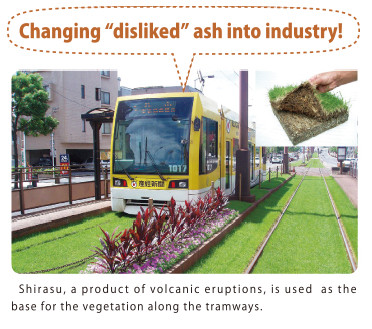
-
There are many treasures utilizing blessing of the volcano and the sea in Sakurajima.
For example, Sakurajima small mandarins grow on the sunny slope utilizing the good drainage of the volcanic geology and the sunshine reflected by Kinko-Bay.
There are also pottery used volcanic ash, ash-dried fish, glass work and cosmetics using Shirasu, and grilled meat plates made by lava. The hot springs are absolutely a blessing of the volcano. Kagoshima has the most hot springs among the capital cities in Japan. The people in Kagoshima are strong enough to make good use of the “disliked” volcanic ash in the industry.

The Castle of Satsuma is Shirasu Tableland!
-

-
The history of Kagoshima cannot be described without the volcano. The remains of the shell mound in Sakurajima is proof that people have beeen living with the volcano since the Jomon period of Japan. There is a trace of a debris flow as well. However people have continued to live on Sakurajima as the blessing outweight the disaster.
Also, the stone culture of Kagoshima owes to the volcano. Welded tuff, a volcanic ejecta, is softer than other stones, thus it is easy to process. Many historical buildings such as the machine shop of Shuseikan(*2) and the stone bridge are made of welded tuff.
Access to Kurokami Buried Shirine Gate
-
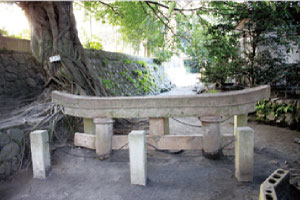
-
Local bus
- You cannot go to Kurokami Buried Shrine Gate by Sakurajima Island View Bus.
- A One-day Pass is reasonable and convenient for the routes below.
(Route 1)
Transfer at
'Higashi Shirahama'- Take Kagoshima city bus #60 From 'Sakurajima Port' to 'Higashi Shirahama' (about 20 min)
-
At 'Higashi Shirahama' Take Kagoshima city bus #70
From 'Higashi Shirahama' to'Kurokami chugakko mae' (about 20 min)
(Route 2)
Direct-
Take Kagoshima city bus #60
From 'Sakurajima Port' to 'Kurokami Chugakko mae' (about 35 min)
Car or taxi
- About 20km from Sakurajima Port (about 30 min)

Kagoshima’s high quality service!
-

-
People of Kagoshima live besides the active volcano, Sakurajima. The Annei eruption in Edo Period made people move from Kurokami to Uenohara. From Uenohara, they were able to see the beautiful scenery of their hometown, Sakurajima.
Also the disaster heritage Kurokami Buried Shrine Gate, 2m of the gate was buried by the ash in a single day, has been kept as it was to reminds the residents of the disaster. The gate is now located inside Kurokami junior high school. While Sakurajima has has been very active over 50 years, people in Kagoshima have lived coping with the ash, applying their knowledge and experience well into their life.
